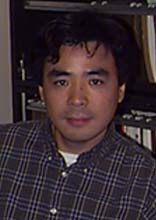 |
Many cytokines have dual but opposite effects on cells,
i.e., they can stimulate growth and maintain survival in some cell types
but inhibit growth and induce apoptosis in others. Molecular studies have
demonstrated that these cytokines (e.g., TNF) can trigger two opposite
signaling events in cells. Thus, in cells that yin-yang relationship is
epitomized by opposite signaling events: phosphorylation is balanced by
dephosphorylation; Caspase activation is balanced by NF-KB transactivation.
Disruption of this balance can lead to cell death or cancer. The Jak-STAT
pathway is a recently discovered signaling route used by a variety of
cytokines and growth factors. Stat1 activation by either interferon or EGF
links to cell growth arrest or death. We use a combination of molecular,
biochemical, and cell-biological approaches to study mechanisms by which
the Jak-STAT pathway controls cell growth or death. We wish to define the
roles of other STAT family members in cell growth/death control. Domain
analysis of STAT family members indicates that STAT proteins share strong
homology in several segments of their sequences. We are in the process of
developing strategy to analyze these domains in order to understand how
they function in signal transduction and transactivation of target genes.
Different domains of STAT may interact with different proteins. We try to
identify new cellular components interacting with specific domains of STAT
by using our newly invented protein-array technology. We wish to identify
and characterize cell growth/death related genes that are activated in
response to STAT activation. We try to explore whether tyrosine
phosphorylation and STATs are involved in TNF receptor signaling pathway,
and their relationship with apoptosis and diseases such as diabetes. Thus
the principle of yin and yang, the balance between opposing natural forces
is emphasized as a fundamental property of growth regulation. Our
understanding of growth/death control and its derangements in diseases
depends on the discovery of these regulatory molecules and their functions.
Chin, Y. E., et al. (1996) Cell growth arrest and
induction of cyclin-dependent kinase inhibitor p21WAF1/CIP1 mediated by
STAT1. Science 272:719-722.
Chin, Y. E., et al. (1997) Activation of STAT signaling pathway can cause
expression of Caspase 1 and apoptosis. Mol. Cell. Biol. 17:5328-5337.
Chin, Y. E. and Fu, X.-Y. (1998) Control of apoptosis through gene
regulation. In Apoptosis Genes Potten, C. S., Booth, C., and Wilson, J. W.
eds.p119-142.
Iwamoto, Y., et al. (1998) Identification and characterization of an EGF
receptor associated STAT inhibitor. J. Biol. Chem. 273:18198-18204.
Welte, T., et al. (1999) STAT5 interaction with the T cell receptor complex
and stimulation of T Cell proliferation. Science 283:222-225.
Wang, Y., et al. (2000) Stat1 as a component of tumor necrosis factor alpha
receptor 1-TRADD signaling complex to inhibit NF-kappaB activation. Mol Cell Biol. 20:4505-4512.
|
